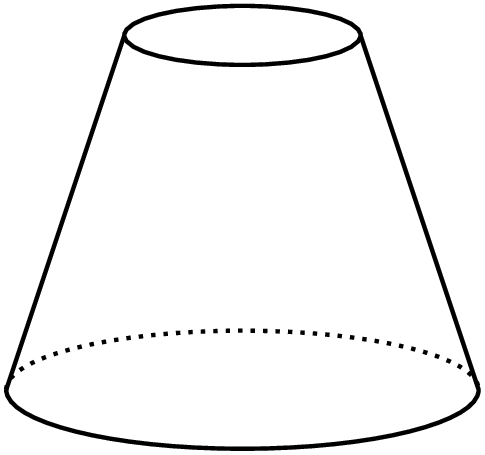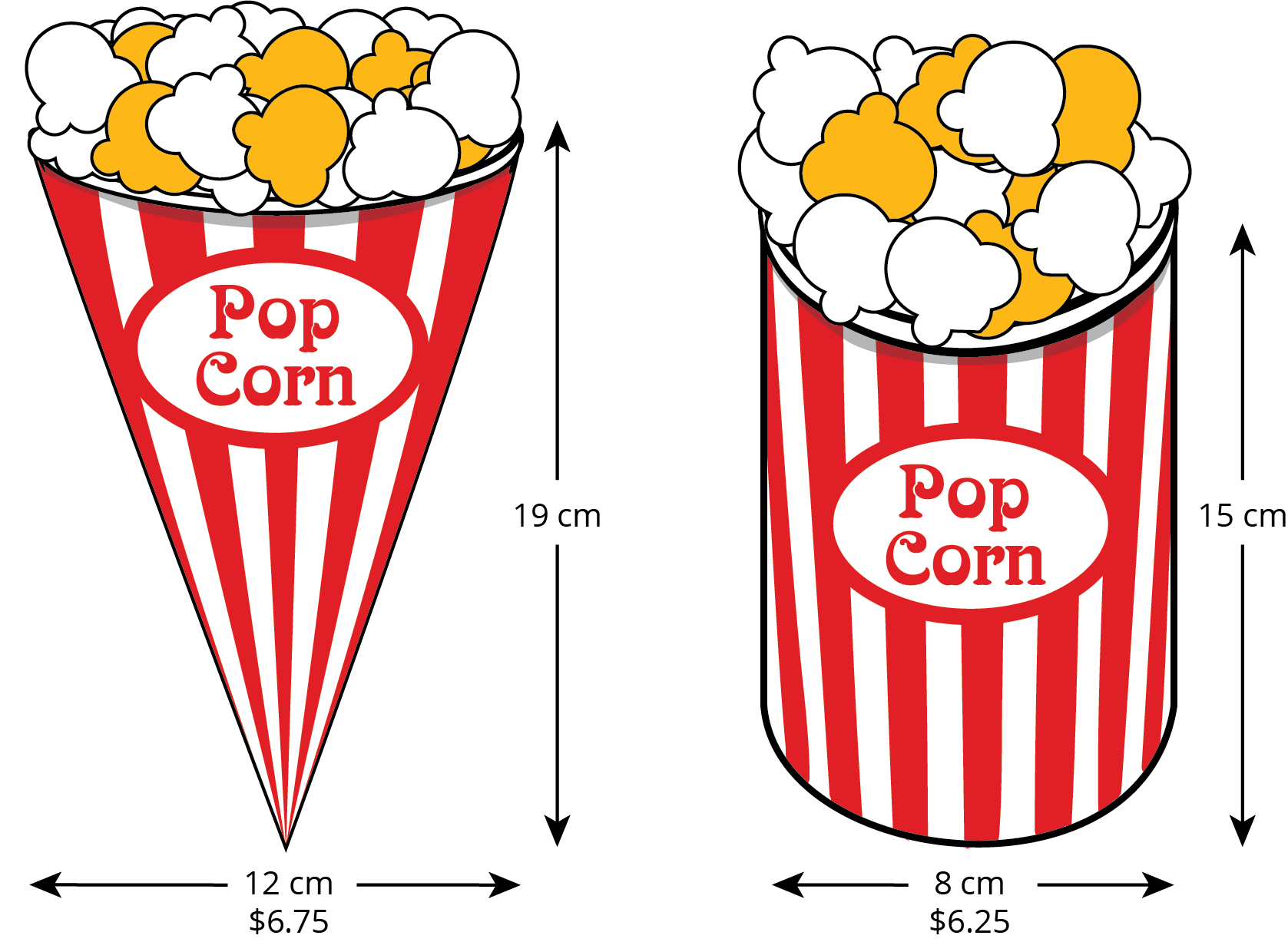Lesson 20
Finding Cone Dimensions
20.1: Number Talk: Thirds (5 minutes)
Warm-up
The purpose of this number talk is to elicit understandings and review strategies students have for finding the unknown value in an equation that involves the fraction \(\frac13\). These understandings will be helpful later in this lesson when students are solving for the unknown length of the radius or height of a cone given its volume.
While four problems are given, it may not be possible to share every strategy. Consider gathering only two or three different strategies per problem, saving most of the time for the final question.
Launch
Reveal one problem at a time. Give students brief quiet think time for each problem, and ask them to give a signal when they have an answer and a strategy. Keep all previous problems displayed throughout the talk. Follow with a whole-class discussion.
Supports accessibility for: Memory; Organization
Student Facing
For each equation, decide what value, if any, would make it true.
\(27=\frac13h\)
\(27=\frac13r^2\)
\(12\pi=\frac13\pi a\)
\(12\pi=\frac13\pi b^2\)
Student Response
For access, consult one of our IM Certified Partners.
Anticipated Misconceptions
Students might want to divide 27 by 3 or multiply 27 by \(\frac13\) to solve for \(h\). Ask students what number you can multiply by \(\frac13\) (or divide by 3) to result in the number 27.
Activity Synthesis
Ask students to share their strategies for each problem, in particular highlighting the ways students worked with the fraction \(\frac13\). Record and display their explanations for all to see. To involve more students in the conversation, consider asking:
- “Who can restate ___’s reasoning in a different way?”
- “Did anyone have the same strategy but would explain it differently?”
- “Did anyone solve the problem in a different way?”
- “Does anyone want to add on to _____’s strategy?”
- “Do you agree or disagree? Why?”
Design Principle(s): Optimize output (for explanation)
20.2: An Unknown Radius (5 minutes)
Optional activity
The purpose of this activity is for students to calculate the radius of the cone given the volume and height. This activity is similar to an activity in a previous lesson where students calculated the radius of a cylinder given the volume and height. A difference here is that solving for the unknown takes an additional step to deal with the \(\frac13\).
Encourage students to connect the strategies that they used in the warm-up to this problem. Identify students who make the connections and ask them to share during the discussion.
Launch
Arrange students in groups of 2. Give students 2–3 minutes of quiet work time followed by time to share their strategies with their partner. Follow with a whole-class discussion.
Student Facing
The volume \(V\) of a cone with radius \(r\) is given by the formula \(V=\frac13 \pi r^2h\).

The volume of this cone with height 3 units and radius \(r\) is \(V=64\pi\) cubic units. This statement is true:
\(\displaystyle 64\pi =\frac13 \pi r^2 \boldcdot 3\) What does the radius of this cone have to be? Explain how you know.
Student Response
For access, consult one of our IM Certified Partners.
Anticipated Misconceptions
Students might struggle with the \(\frac13\) while solving for the unknown radius length. Encourage students to think about the strategies they used in the warm-up to work with the \(\frac13\).
Activity Synthesis
Select previously identified students to share the strategies they used to calculate the radius. Ask students, “Which do you think is more challenging: calculating the radius of a cone or the radius of the cylinder when the height and volume of the shapes are known? Why?” (I think they are the same, you just have to work with \(\frac13\) when calculating the radius of the cone, which adds an extra step.)
20.3: Cones with Unknown Dimensions (15 minutes)
Activity
The purpose of this activity is for students to use the structure of the volume formula for cones to calculate missing dimensions of a cone given other dimensions. Students are given the image of a generic cone with marked dimensions for the radius, diameter, and height to help their reasoning about the different rows in the table.
While completing the table, students work with approximations and exact values of \(\pi\) as well as statements that require reasoning about squared values. The final row of the table asks students to find missing dimensions given an expression representing volume that uses letters to represent the height and the radius. This requires students to manipulate expressions consisting only of variables representing dimensions.
Encourage students to make use of work done in some rows to help find missing information in other rows. Identify students who use this strategy, and ask them to share during the discussion.
Launch
Give students 6–8 minutes of quiet work time, followed by a whole-class discussion.
Supports accessibility for: Organization; Attention
Student Facing

Each row of the table has some information about a particular cone. Complete the table with the missing dimensions.
| diameter (units) | radius (units) | area of the base (square units) | height (units) | volume of cone (cubic units) |
|---|---|---|---|---|
| 4 | 3 | |||
| \(\frac{1}{3}\) | 6 | |||
| \(144\pi\) | \(\frac14\) | |||
| 20 | \(200\pi\) | |||
| 12 | \(64\pi\) | |||
| 3 | 3.14 |
Student Response
For access, consult one of our IM Certified Partners.
Student Facing
Are you ready for more?
A frustum is the result of taking a cone and slicing off a smaller cone using a cut parallel to the base.

Find a formula for the volume of a frustum, including deciding which quantities you are going to include in your formula.
Student Response
For access, consult one of our IM Certified Partners.
Anticipated Misconceptions
Students might try to quickly fill in the missing dimensions without the proper calculations. Encourage students to use the volume of a cone equation and the given dimensions to figure out the unknown dimensions.
Activity Synthesis
Select previously identified students to share the strategies they used to fill in the missing information. Ask students:
- “Which information, in your opinion, was the hardest to calculate?”
- “If you had to pick two pieces of information given in the table which information would you want? Why?”
Select a few rows of the table, and ask students how they might find the volume of a cylinder with the same radius and height as the cone. (Multiply by 3)
Make sure students understand that when working with the volume formula for either a cylinder or cone, if they know two out of three for radius, height and volume, they can always calculate the third.
Design Principle(s): Support sense-making; Optimize output (for explanation)
20.4: Popcorn Deals (10 minutes)
Activity
The purpose of this activity is for students to reason about the volume of popcorn that a cone- and cylinder-shaped popcorn cup holds and the price they pay for it. Students start by picking the popcorn container they would buy (without doing any calculations) and then work with a partner to answer the question of which container is a better value. This activity is designed for the discussion to happen around a few different concepts:
- The volume is a lower estimate because there is still some popcorn coming out the top of the containers.
- The fact that one container (the cone) looks like it has more coming out of the top might sway students to think that the cone is a better deal. However, the difference in the volume amounts should support the fact that even with a taller and wider diameter the cone still holds less volume than the cylinder.
- Why would the movie theater purposefully sell a container that has less volume for more price?
Identify groups who see these connections while they are working on the task, and ask them to share their arguments during the discussion.
Launch
Arrange students in groups of 2. Give students 1 minute of quiet think time to decide which popcorn container they would purchase. Students are not asked to use any written calculations to determine this answer. Poll the class and display the results for all to see which containers students chose. Keep this information displayed to refer back to during the discussion.
Give students 2–3 minutes of time to work with their partner to determine which container is a better value. Follow with a whole-class discussion.
Supports accessibility for: Language; Organization
Design Principle(s): Maximize meta-awareness; Support sense-making
Student Facing
A movie theater offers two containers:

Which container is the better value? Use 3.14 as an approximation for \(\pi\).
Student Response
For access, consult one of our IM Certified Partners.
Anticipated Misconceptions
Students may try to use just the image to reason about which is a better deal. Make sure they understand that the image of the two containers is not to scale.
Activity Synthesis
Poll the class again for which container they would purchase. Display the new results next to the original results for all to see during the discussion.
Select previously identified groups to share their arguments for which container has a better value. Encourage groups to share details of their calculations and record these for all to see in order to mark any similarities and differences between the groups’ arguments. Consider asking some of the following questions to help students think deeper about the situation:
- “Do you think your volume calculations overestimate or underestimate the amount of popcorn each container can hold?” (I think the calculations underestimate because the popcorn piles higher than the lip of the container.)
- “Why do you think movie theaters charged more for the cone?” (It may look like it has more volume to some people since it has a larger diameter and height. It may be easier to place into a cup holder.)
- “Do you think a lot of people would buy the cone over the cylinder?” (Yes. The 50 cent difference is not a lot, and since it is taller and wider, people might think the cone is bigger. Although the cylinder is a better value, there may be other considerations like how easy the cup is to hold or put in the cup holder in the seat, or whether you have time in line to calculate the value.)
Lesson Synthesis
Lesson Synthesis
Display the image of the popcorn cone from the activity Popcorn Deals, including the dimensions of the cone. Ask students, “What size of cylinder cup would you need to have the same volume as the cone?”
Working in groups of 2, tell partners to determine the height and radius of a possible cylinder of equivalent volume, including making a sketch with labels on the dimensions. Display sketches and invite students to share the strategies they used to find their cylinders.
20.5: Cool-down - A Square Radius (5 minutes)
Cool-Down
For access, consult one of our IM Certified Partners.
Student Lesson Summary
Student Facing
As we saw with cylinders, the volume \(V\) of a cone depends on the radius \(r\) of the base and the height \(h\):
\(\displaystyle V=\frac13 \pi r^2h\)
If we know the radius and height, we can find the volume. If we know the volume and one of the dimensions (either radius or height), we can find the other dimension.
For example, imagine a cone with a volume of \(64\pi\) cm3, a height of 3 cm, and an unknown radius \(r\). From the volume formula, we know that
\(\displaystyle 64 \pi = \frac{1}{3}\pi r^2 \boldcdot 3\)
Looking at the structure of the equation, we can see that \(r^2 = 64\), so the radius must be 8 cm.
Now imagine a different cone with a volume of \(18 \pi\) cm3, a radius of 3 cm, and an unknown height \(h\). Using the formula for the volume of the cone, we know that
\(\displaystyle 18 \pi = \frac{1}{3} \pi 3^2h\)
so the height must be 6 cm. Can you see why?